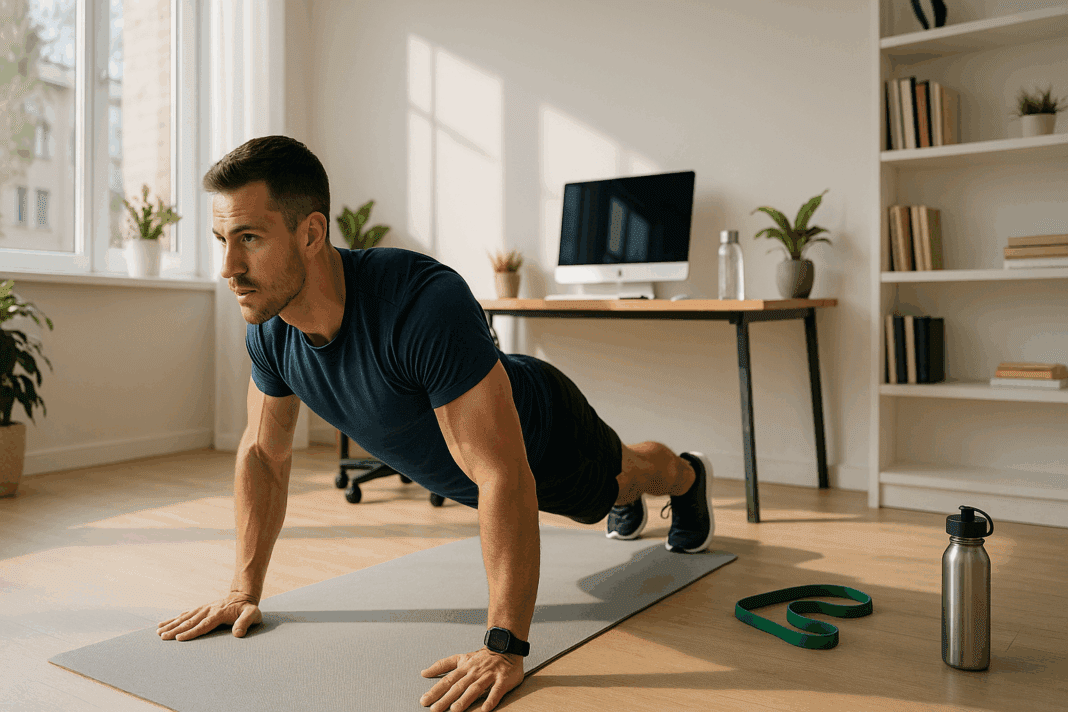Introduction: Why Strength Matters More Than Ever for Busy Professionals
In an age where careers demand more attention, energy, and time than ever before, the need for physical resilience, mental clarity, and emotional stability has become paramount. Strength training, long celebrated by athletes and fitness enthusiasts, is now a non-negotiable cornerstone for professionals striving to maintain peak performance amidst their demanding schedules. Not only does strength training enhance muscular endurance and bone density, but it also plays a pivotal role in improving cognitive function, reducing stress, and fostering better sleep patterns. For those without hours to spend in the gym, finding effective home workout routines for busy professionals has become a vital part of sustaining health and productivity.
The beauty of a home-based strength routine lies in its accessibility and adaptability. Whether squeezed into a 20-minute morning session or a focused routine during a lunch break, home workouts can deliver transformative results with minimal equipment and maximum efficiency. This article presents a comprehensive blueprint tailored specifically for professionals seeking to integrate fitness seamlessly into their lives without sacrificing performance in the workplace. Through science-backed strategies, realistic scheduling tips, and expertly designed movements, readers will discover how to cultivate strength that empowers both body and career.
You may also like: The Ultimate 30-Day Workout Plan for Men Working Out in the Gym: Proven Full Body Strength Exercises to Maximize Results
Understanding the Science of Strength Training
Strength training, at its core, involves resistance exercises designed to improve muscle strength, endurance, and power. It encompasses a range of modalities—from bodyweight exercises and resistance bands to free weights and compound lifts. For busy professionals working from home, bodyweight movements and minimal-equipment routines are often the most realistic and sustainable options. However, understanding the physiological basis of strength training is essential to maximize its effectiveness.
When muscles are challenged with resistance, microtears occur in the muscle fibers. During recovery, the body repairs and strengthens these fibers, resulting in hypertrophy—an increase in muscle size—and neuromuscular adaptations that improve coordination and power. Consistent strength training also enhances metabolic rate, leading to more efficient calorie utilization, even at rest. Furthermore, strength-based workouts stimulate the production of anabolic hormones such as testosterone and growth hormone, contributing to long-term health benefits.
Professionals who integrate strength workouts into their weekly routines often report greater energy levels, improved concentration, and better stress management. These benefits stem from both physiological responses and the psychological empowerment that accompanies physical capability. When approached methodically and paired with proper nutrition and rest, strength training becomes more than a fitness regimen; it becomes a life-enhancing practice.

Designing Daily Workout Plans for Busy People
Creating daily workout plans for busy people requires intentionality, precision, and a clear understanding of one’s unique schedule. Unlike traditional fitness programs that assume the availability of long gym sessions, daily plans for working professionals must prioritize efficiency and flexibility. The key is to break the week into micro-cycles that focus on different muscle groups or functional objectives.
A well-structured weekly plan might include three full-body strength sessions, two mobility or recovery-focused routines, and one optional day for cardiovascular training. These sessions can range from 20 to 45 minutes, depending on time availability, and should be strategically placed around peak workload hours to enhance consistency. For instance, a 6 a.m. bodyweight circuit might energize the morning, while a post-lunch band workout could serve as a reset before afternoon meetings.
To maintain engagement and prevent burnout, workout plans should incorporate variation. Alternating between upper-body, lower-body, and core-focused days ensures balanced muscular development and reduces the risk of overuse injuries. Additionally, integrating compound movements such as squats, push-ups, and planks engages multiple muscle groups simultaneously, maximizing time efficiency. Technology can also support these plans; apps and wearable devices can send reminders, track progress, and offer guided routines.
Ultimately, the most successful daily workout plans for busy people are those that align with individual goals, respect time constraints, and offer adaptability without compromising effectiveness. By committing to a consistent structure, professionals can build fitness into their lives with minimal disruption.
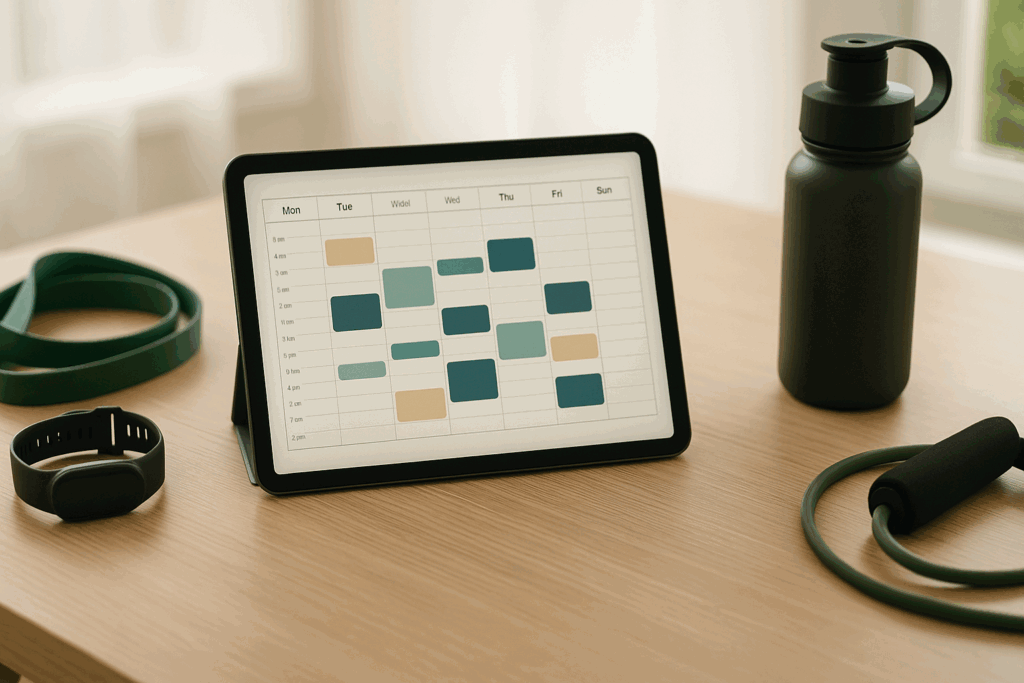
Building Strength with Minimal Equipment at Home
One of the most empowering aspects of modern fitness is the realization that effective strength training does not require a fully stocked gym. In fact, many of the most transformative exercises can be performed with little more than bodyweight, resistance bands, and a sturdy chair. For professionals managing tight schedules and limited space, this opens the door to sustainable home training.
Bodyweight exercises like push-ups, squats, lunges, and planks form the foundation of no-equipment strength routines. These movements not only build muscle but also improve stability, coordination, and mobility. Progressions such as elevated push-ups or Bulgarian split squats add intensity and variety. Resistance bands, on the other hand, offer adjustable resistance that targets specific muscle groups and mimics traditional weight training.
Core strength is often overlooked in standard programs, yet it is crucial for posture, injury prevention, and overall strength. Incorporating exercises like bird dogs, leg raises, and side planks strengthens the midsection and supports better alignment. Professionals who sit for extended periods especially benefit from mobility drills and dynamic stretches that counteract sedentary postures.
With thoughtful selection and progression, minimal-equipment workouts deliver comprehensive strength benefits. They enable consistency, reduce dependency on external facilities, and foster intrinsic motivation. Most importantly, they demonstrate that meaningful fitness outcomes are not reserved for those with time to spare—they are accessible to anyone with a plan and a purpose.
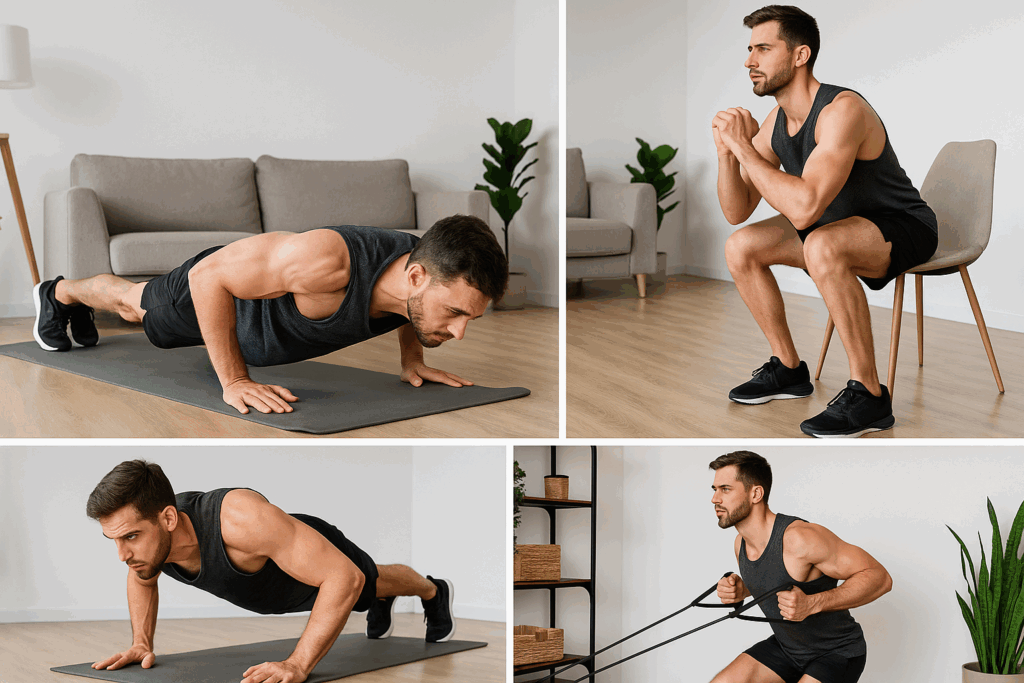
Expert Strategies for Integrating Fitness Routines for Busy Schedules
The greatest challenge for many professionals is not a lack of desire to work out, but a lack of time. Yet, with strategic planning and an understanding of behavioral psychology, integrating fitness routines for busy schedules becomes an achievable goal. The first principle is to reframe exercise not as an additional burden, but as a performance enhancer that fuels every aspect of professional life.
Habit stacking is one proven method to seamlessly incorporate workouts into daily routines. By pairing a short workout with an existing habit—such as doing a five-minute mobility routine after brushing your teeth or a quick resistance set before showering—fitness becomes automatic. Calendar blocking is another effective strategy; treating workouts as non-negotiable meetings reinforces their importance and increases adherence.
Time-efficient methods like high-intensity interval training (HIIT) and circuit training offer maximal benefits in minimal time. A 20-minute circuit alternating squats, push-ups, and mountain climbers can elevate heart rate, build strength, and burn calories without requiring extended sessions. Incorporating movement breaks throughout the workday—even if only for two minutes at a time—can cumulatively improve physical and mental well-being.
Professionals should also assess their chronotypes and energy patterns. Some individuals thrive on morning workouts, while others perform better in the evening. Aligning workout timing with natural rhythms enhances consistency and enjoyment. Finally, maintaining a sense of flexibility and self-compassion is critical; missing a session should not derail the entire routine. Resilience, not perfection, is the hallmark of a sustainable fitness practice.
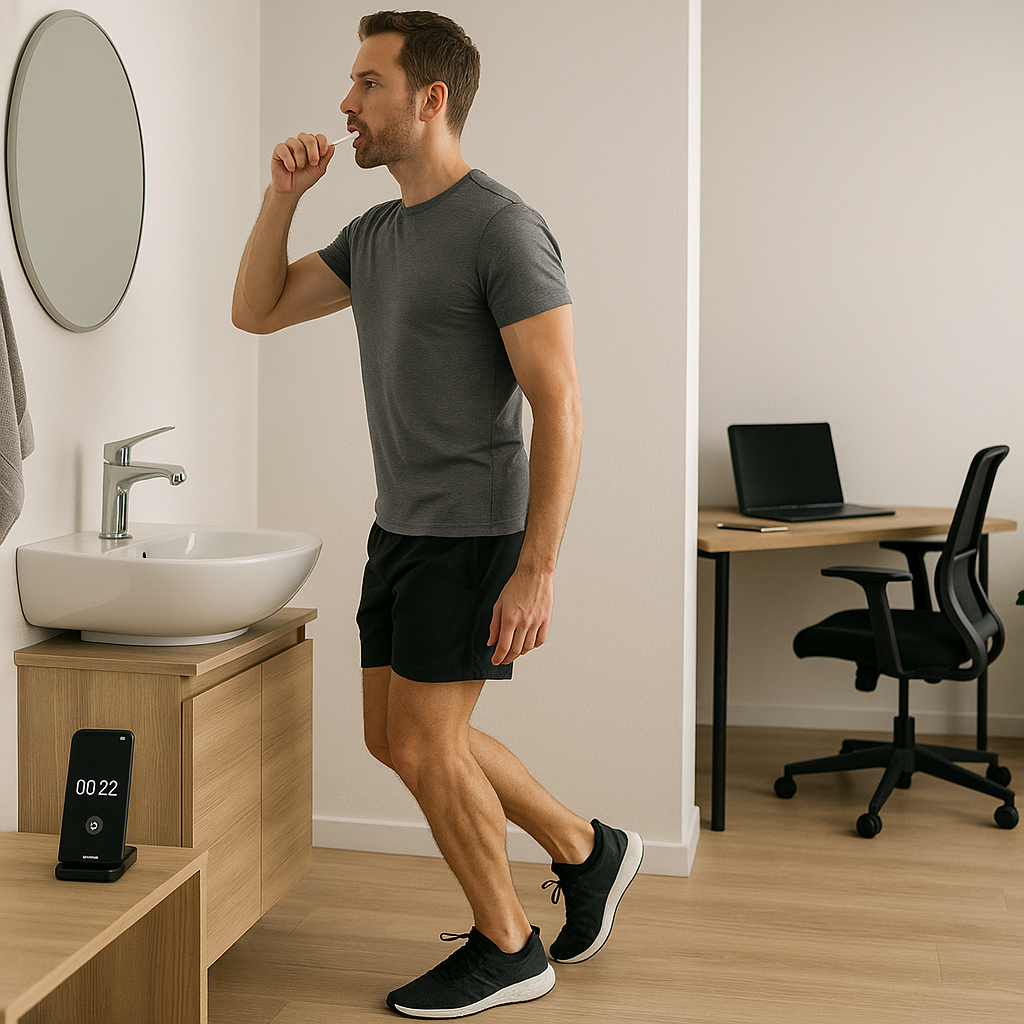
Home Workout Routines for Busy Professionals: Full-Body Foundations
Developing full-body strength is essential for functional performance and injury prevention, especially for individuals managing multiple responsibilities. Home workout routines for busy professionals can achieve this through foundational exercises that target major muscle groups in a balanced manner. These routines emphasize time efficiency while delivering comprehensive results.
A typical full-body home routine might include a sequence of squats, push-ups, planks, glute bridges, and superman holds. Each movement targets different regions of the body, ensuring symmetrical development. Circuit-style execution keeps the heart rate elevated, blending cardiovascular conditioning with strength building. By focusing on compound movements, these workouts make the most of limited time without sacrificing effectiveness.
Professionals can modify intensity by adjusting tempo, adding isometric holds, or incorporating resistance bands. A 30-second squat hold or a slow push-up descent increases time under tension and stimulates muscle growth. These small tweaks elevate the training stimulus without extending the workout duration. Additionally, scheduling two to three of these sessions per week provides sufficient stimulus for strength adaptation.
Tracking progress is important for motivation and improvement. Journaling reps, sets, and perceived effort fosters awareness and accountability. When combined with adequate recovery and nutrition, these routines not only build muscle but also enhance energy, posture, and resilience in daily life. Strength becomes an asset that supports both physical demands and mental clarity.
Time-Efficient Home Workout Routines for Busy Professionals
Efficiency is the cornerstone of successful fitness integration in demanding lifestyles. Time-efficient home workout routines for busy professionals leverage smart programming and purposeful movement to deliver results without monopolizing the schedule. These workouts capitalize on compound exercises and interval structures to stimulate multiple systems simultaneously.
One effective structure is the AMRAP (As Many Rounds As Possible) format, where a set of exercises is repeated for a fixed duration. For example, a 15-minute AMRAP of bodyweight squats, chair dips, and mountain climbers challenges endurance and strength in a condensed window. Another method is the EMOM (Every Minute On the Minute) approach, which sets a specific task to complete each minute, allowing for rest only in the remaining seconds.
Supersets—pairing two exercises back-to-back—maximize training density and keep rest intervals short. A superset of push-ups and reverse lunges, for instance, targets upper and lower body muscles while maintaining a steady pace. Tabata intervals, consisting of 20 seconds of work followed by 10 seconds of rest for eight rounds, are particularly effective for metabolic conditioning and fat burning.
Even five- to ten-minute “micro-workouts” throughout the day can cumulatively provide substantial training volume. The key is consistency and intensity rather than duration. Busy professionals should prioritize quality movement, mindful breathing, and deliberate pacing over sheer volume. By aligning workouts with realistic timeframes, consistency becomes sustainable and rewarding.
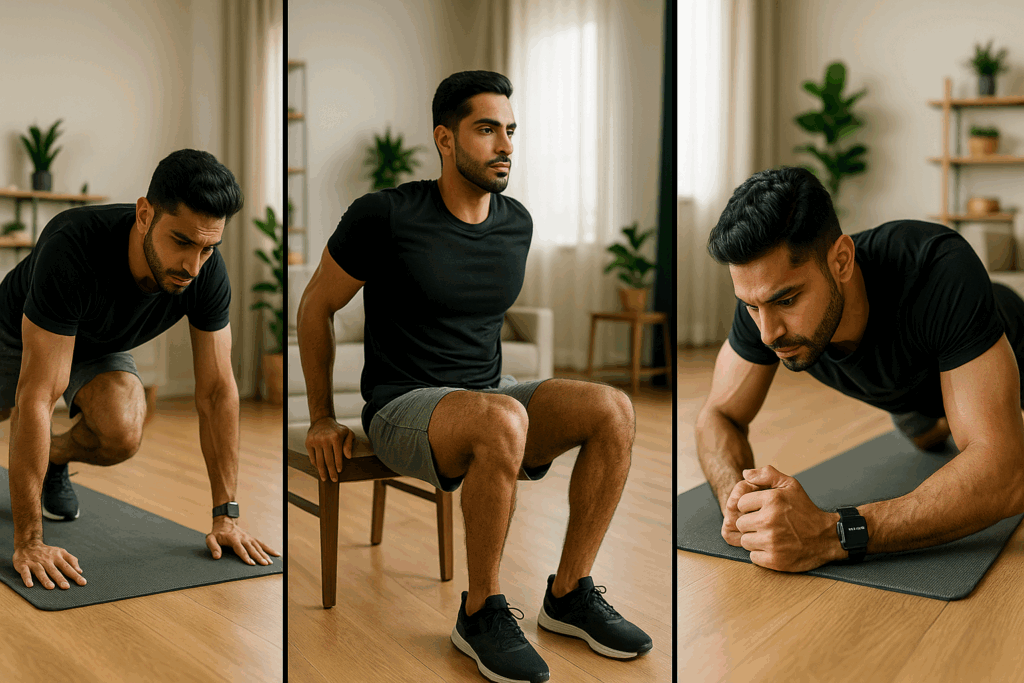
Structuring Fitness Routines for Busy Schedules Across the Workweek
Designing a sustainable weekly schedule is critical for long-term success. Fitness routines for busy schedules must be tailored to accommodate fluctuating work demands, energy levels, and life responsibilities. A well-structured plan offers both predictability and flexibility, providing a reliable framework while allowing room for spontaneity.
One practical approach is the three-day split: Monday for full-body strength, Wednesday for mobility and core, and Friday for upper and lower body circuits. On alternate days, professionals can engage in light activity such as walking, yoga, or stretching to support recovery. Sundays can be designated for reflection, planning, or restorative movement.
Another model is the “ladder” format, where intensity increases progressively throughout the week. Starting with a moderate-intensity session and culminating in a high-intensity workout builds psychological momentum and reduces early-week fatigue. Alternatively, the “wave” structure alternates high and low-intensity days to manage stress and avoid burnout.
Adaptability is crucial. Unexpected meetings, travel, or family obligations may disrupt plans. Rather than abandoning workouts entirely, professionals can scale the intensity or duration. A 10-minute stretch session or a single round of a circuit preserves continuity and reinforces commitment. Over time, these small adjustments cultivate a resilient mindset and a durable fitness habit.
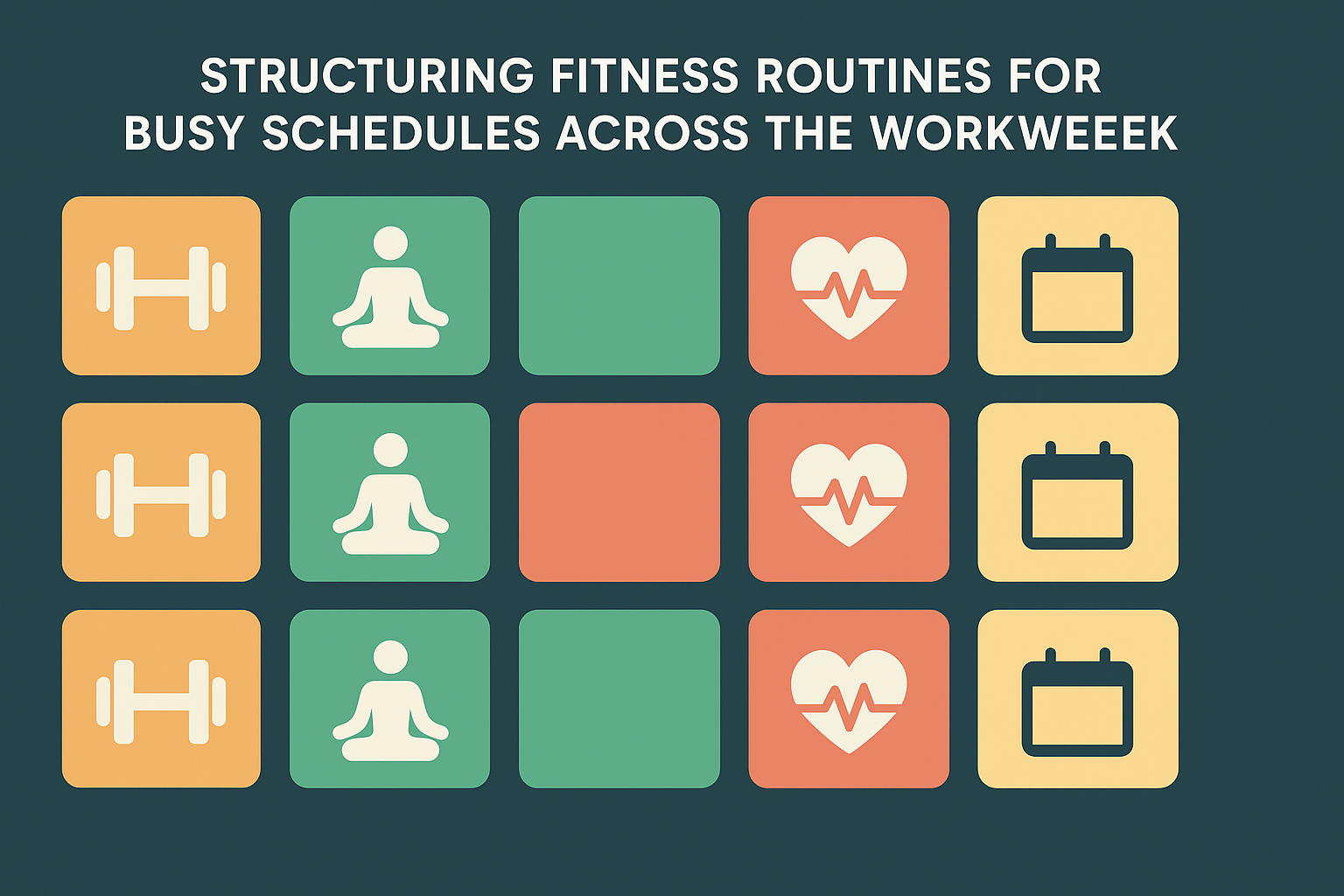
Home Workout Routines for Busy Professionals to Build Long-Term Strength
Sustained strength development requires more than occasional bursts of activity; it demands a thoughtful progression strategy. Home workout routines for busy professionals can follow a periodized model that evolves over time to prevent plateaus and foster continued growth. This long-term approach balances overload with recovery and skill development.
Beginners can start with foundational movements performed consistently two to three times per week. Once movement patterns are mastered, variables such as volume, intensity, and complexity can be gradually increased. Introducing tempo changes, unilateral movements, or resistance tools deepens the stimulus and recruits more muscle fibers.
Intermediate and advanced individuals can implement training blocks focusing on specific outcomes—such as hypertrophy, endurance, or power. Each block can last four to six weeks, followed by a de-load or recovery phase. This strategy not only prevents overtraining but also maintains engagement by varying goals and stimuli.
Consistency remains the golden rule. Even during high-stress periods, maintaining a reduced but regular workout frequency preserves neuromuscular coordination and metabolic efficiency. By treating strength as a long-term investment rather than a short-term fix, professionals develop a capacity that supports both personal and professional excellence.
Nutrition and Recovery: Fueling Strength and Resilience
No strength program is complete without attention to nutrition and recovery. The demands of home workout routines, especially for busy professionals, require deliberate fueling strategies and restorative practices. Nutrition directly influences energy availability, muscle repair, hormonal balance, and cognitive clarity.
A balanced intake of protein, complex carbohydrates, healthy fats, and micronutrients supports performance and adaptation. Protein sources such as lean meats, legumes, and dairy facilitate muscle repair, while carbohydrates replenish glycogen stores. Healthy fats contribute to hormonal function and inflammation regulation. Timing also matters; a protein-rich meal within an hour post-workout enhances recovery.
Hydration is often overlooked yet essential. Dehydration impairs strength, focus, and endurance. Professionals should aim for consistent fluid intake throughout the day, especially around workouts. Supplementation with omega-3 fatty acids, vitamin D, and magnesium may also support recovery, depending on individual needs.
Sleep is the cornerstone of recovery. Deep sleep stages are when muscle repair and memory consolidation occur. Aim for seven to nine hours per night, prioritizing sleep hygiene practices such as screen curfews, cool temperatures, and a consistent bedtime. Rest days, mobility work, and mindfulness practices further reinforce resilience and readiness.
By aligning nutrition and recovery with training demands, busy professionals not only enhance their strength outcomes but also improve their cognitive performance and emotional regulation—traits invaluable in both fitness and leadership.

Frequently Asked Questions: Strength Training and Home Fitness for Professionals
1. What are the best ways to stay consistent with home workout routines for busy professionals?
Staying consistent with home workout routines for busy professionals begins with creating a reliable structure that fits your life rather than forcing your life to conform to your fitness plan. One powerful strategy is to integrate exercise into established routines, such as doing a 10-minute strength circuit immediately after your morning coffee or before winding down in the evening. Utilizing visual cues—like leaving your resistance band on your desk—can also serve as gentle reminders to move. Professionals benefit from pre-scheduling their workouts as calendar events, giving them the same priority as meetings or deadlines. Finally, mixing variety into your workouts, such as alternating strength circuits with mobility-focused days, helps reduce boredom and encourages long-term adherence.
2. How can I ensure progress without using traditional gym equipment?
Progress in strength training doesn’t require barbells or machines. Progressive overload—the principle of gradually increasing the stress placed on muscles—can be applied at home through different methods. These include increasing reps, slowing down tempo to maximize time under tension, or reducing rest periods between sets. Resistance bands offer scalable intensity and mimic many gym-based movements, making them ideal tools for busy professionals. Additionally, mastering advanced variations of bodyweight exercises—such as pistol squats, wall walks, and elevated planks—can lead to significant strength gains over time. Tracking metrics like form quality, number of sets, and recovery speed can also give clear indicators of progress.
3. Can home-based daily workout plans for busy people still offer cardiovascular benefits?
Absolutely. While many associate cardiovascular health with running or cycling, strength-based daily workout plans for busy people can deliver substantial heart benefits when designed properly. High-intensity interval training (HIIT) using bodyweight exercises like burpees, jump squats, and mountain climbers rapidly elevates heart rate, promoting cardiovascular conditioning in short bursts. Additionally, circuit training with minimal rest encourages both muscular and aerobic development. Even short “movement snacks”—such as three five-minute sessions scattered throughout the day—accumulate cardiovascular value. Incorporating a jump rope or performing compound exercises continuously for extended sets keeps the heart engaged, even without formal cardio equipment.
4. How do fitness routines for busy schedules support mental health?
Fitness routines for busy schedules have a remarkable impact on mental health, particularly in high-stress careers. Regular movement stimulates the release of endorphins and serotonin, enhancing mood and reducing symptoms of anxiety or depression. Even brief workouts act as mental resets, breaking up the monotony of long workdays and improving cognitive clarity. Physical activity also promotes better sleep, which directly supports emotional regulation and resilience. For professionals juggling multiple roles, these routines become essential tools for emotional self-care, helping them manage workload pressures more effectively and maintain focus and positivity.
5. What are common pitfalls when designing home workout routines for busy professionals?
One common pitfall is underestimating the importance of planning. Without a predefined structure, workouts often become sporadic or inconsistent, especially when fatigue sets in. Another issue is neglecting recovery—many driven individuals push through soreness or stress, increasing injury risk. Some professionals fall into the trap of repeating the same workout without progression, which can lead to stagnation. Others may isolate muscle groups inefficiently, rather than using compound exercises that maximize time and results. Avoiding these pitfalls requires a flexible yet strategic approach, with built-in variation, recovery windows, and a focus on functional, total-body movements.
6. How can I balance my fitness goals with family or caregiving responsibilities?
Balancing fitness with caregiving requires creativity and prioritization. One approach is involving family members—such as turning workout time into a family activity or using a child’s nap time as a dedicated fitness window. Early mornings or late evenings often provide uninterrupted periods for movement. Multi-tasking can also help; for instance, performing squats or lunges while supervising a child’s playtime. Choosing flexible fitness routines for busy schedules allows caregivers to maintain their health without sacrificing family time. Most importantly, viewing exercise as self-care—not indulgence—helps shift the mindset from guilt to empowerment.
7. What role does technology play in sustaining home workout routines?
Technology has revolutionized how professionals stay fit at home. From on-demand workout platforms to AI-driven coaching apps, users can access expert-designed routines that evolve with their progress. Smartwatches and fitness trackers provide feedback on effort levels, steps taken, and calories burned, offering motivational data points. Calendar integrations and reminders help with routine adherence, while wearable heart rate monitors optimize training intensity. Virtual communities also create accountability and camaraderie, especially valuable for solo exercisers. Used wisely, technology personalizes and enhances home workout routines for busy professionals by making them measurable, adaptive, and social.
8. How can I maintain motivation over the long term?
Long-term motivation stems from clarity of purpose, visible results, and emotional connection to one’s fitness journey. Setting performance-based goals—such as increasing push-up reps or mastering a new movement—can be more engaging than aesthetic goals alone. Periodic challenges or theme weeks add novelty and excitement. Celebrating milestones with non-food rewards, like new workout gear, reinforces progress. Revisiting your “why”—be it energy for parenting, stress relief, or improved health—strengthens intrinsic motivation. And joining online communities with similar fitness routines for busy schedules creates accountability and encouragement when discipline wavers.
9. Are home workouts effective for strength-building in older professionals?
Yes, home workouts are not only effective but particularly beneficial for older professionals who may have joint limitations or a need for flexibility. Resistance bands and bodyweight exercises reduce the impact on joints while still promoting muscle growth and bone density. Mobility drills and balance exercises incorporated into home workout routines for busy professionals help maintain functional fitness and reduce the risk of falls or strains. Strength training has also been linked to improved insulin sensitivity and cognitive health in aging adults. Tailored modifications, such as using a chair for support during squats or performing wall push-ups, ensure safety while maintaining efficacy.
10. How do I know if my current plan is one of the best home workout routines for busy professionals?
Evaluating your routine begins with clarity: Are you consistently training at least three times a week? Are your sessions varied enough to prevent plateaus and engage different muscle groups? If you’re progressing in strength, endurance, or flexibility—and feeling more energized rather than depleted—your plan is likely serving you well. Quality home workout routines for busy professionals are efficient, goal-oriented, and sustainable. If you find yourself dreading workouts, experiencing frequent soreness, or not seeing progress, it may be time to reassess your structure, timing, or recovery strategy. Consulting with a certified trainer virtually can also provide tailored feedback for optimization.
Conclusion: Empowering Performance Through Strength and Smart Routine Design
The modern professional landscape demands more than intellectual agility and emotional intelligence; it calls for physical strength, stamina, and strategic self-care. Home workout routines for busy professionals offer a pragmatic, effective, and empowering solution to meet these demands without sacrificing career ambitions or personal well-being.
By understanding the science of strength, implementing daily workout plans for busy people, and designing fitness routines for busy schedules that prioritize both effectiveness and efficiency, individuals can transform their approach to health. The integration of minimal-equipment training, intelligent progression, and sustainable structure allows for lasting change and growth.
Equally important are the often-neglected components of nutrition, recovery, and mental resilience. Together, these pillars form a comprehensive blueprint that equips professionals not only to survive but to thrive—strong in body, focused in mind, and grounded in purpose. Strength training at home is no longer a compromise; it is a catalyst for excellence in every domain of life.
Further Reading:
Personal Trainer’s Guide to Time-Efficient Workouts for Busy Clients


